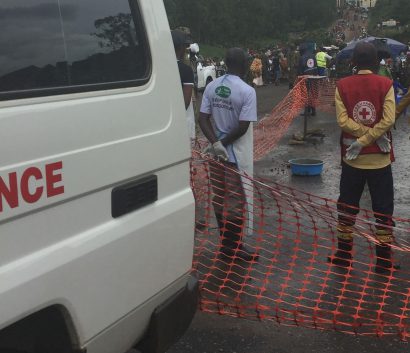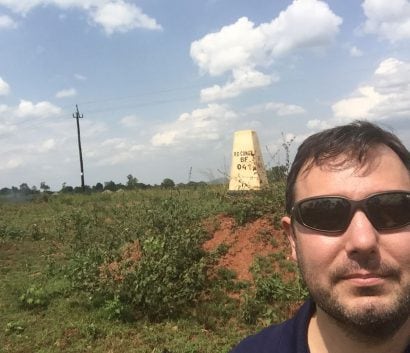
Mpondwe border crossing between Uganda and Democratic Republic of Congo.

Vance Brown
Protecting Uganda’s Border
It was 8 PM on a Friday when Vance Brown, Deputy Director for the Division of Global Health Protection Program in Uganda, got the call. CDC colleagues in the Democratic Republic of the Congo had urgent news: a known contact of an Ebola patient, thought to be at high risk of carrying Ebola themselves, was headed to Kampala. It was close to Christmas, and with unrest around the elections, Ebola screening had been suspended on the DRC side of the border. Vance worked well into the early hours of the next morning coordinating with the Ministry of Health, WHO, and other partners to find out more information. By 2:30 AM, they were confident that they had found the contact—and with additional details, realized that they weren’t considered high risk after all. It was “a real test of our coordination and systems,” Vance recalls.
Vance is no stranger to tests like these. A senior technical advisor to Uganda’s Ministry of Health, Vance has supported a wide range of public health initiatives: from disease surveillance, border health, emergency management, and laboratory systems to vaccine deployment, workforce development, health communication, and logistics. These days he spends most of his time in the Uganda Public Health Emergency Operations Centre, using his considerable experience to assist with day-to-day strategic operations and help to address gaps in the country’s preparedness and response activities. He has even dealt with Ebola before, as the first team lead for health promotion in Sierra Leone and as the deputy for response in Nigeria during the 2014-2016 outbreak. He also helped Sierra Leone transition from Ebola response to post-outbreak preparedness under the Global Health Security Agenda (GHSA).
But every outbreak comes with a new set of challenges. “This response has a very unique aspect in that we have not actually seen a case of Ebola in Uganda. This means as much as we are in ‘response’ mode, much of our work focuses on preparedness and building systems to quickly identify, isolate, and notify from frontline facilities to the central level,” says Vance.
Vance has seen firsthand how strengthening global health security keeps countries, and the world, safer not just from Ebola but other health threats as well. “One of the most telling experiences is the detection of multiple cases of other viral hemorrhagic fevers while trying to strengthen surveillance and response capacity in front-line facilities for Ebola,” Vance notes. By working with partners to provide on-the-ground mentorship to local experts, teams in Kampala were able to detect and respond to a case of Crimean Congo Hemorrhagic Fever (CCHF). “The lab results showed CCHF and teams were able to move quickly to ensure a holistic prevention, detection and response campaign was achieved in under 48 hours of notification.”
“This really re-enforces the work we do under the Global Health Security Agenda to prevent, detect, and respond.”






















.png)











No hay comentarios:
Publicar un comentario